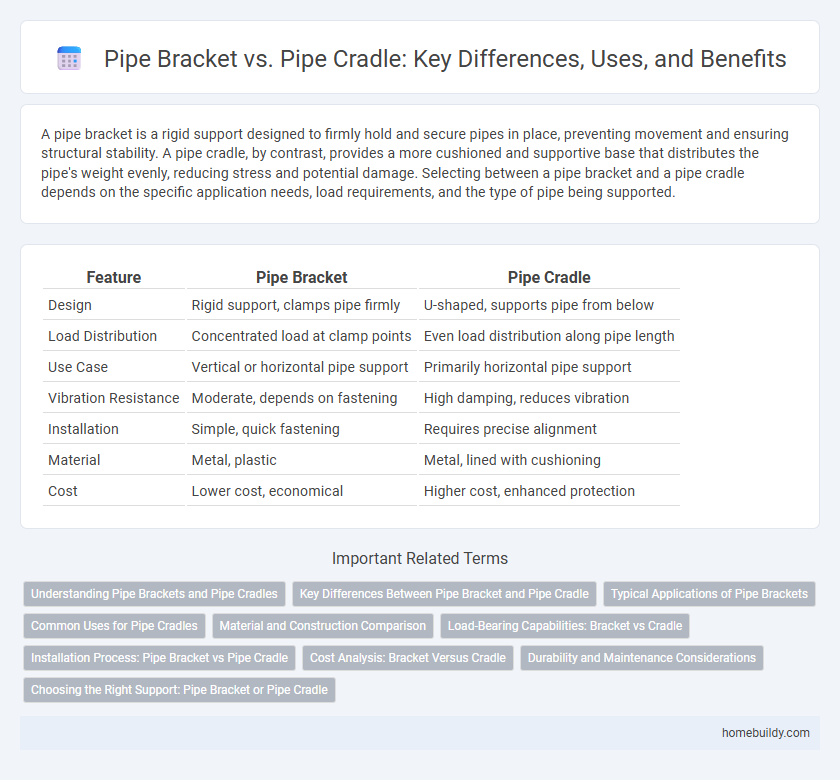A pipe bracket is a rigid support designed to firmly hold and secure pipes in place, preventing movement and ensuring structural stability. A pipe cradle, by contrast, provides a more cushioned and supportive base that distributes the pipe's weight evenly, reducing stress and potential damage. Selecting between a pipe bracket and a pipe cradle depends on the specific application needs, load requirements, and the type of pipe being supported.
Table of Comparison
| Feature | Pipe Bracket | Pipe Cradle |
|---|---|---|
| Design | Rigid support, clamps pipe firmly | U-shaped, supports pipe from below |
| Load Distribution | Concentrated load at clamp points | Even load distribution along pipe length |
| Use Case | Vertical or horizontal pipe support | Primarily horizontal pipe support |
| Vibration Resistance | Moderate, depends on fastening | High damping, reduces vibration |
| Installation | Simple, quick fastening | Requires precise alignment |
| Material | Metal, plastic | Metal, lined with cushioning |
| Cost | Lower cost, economical | Higher cost, enhanced protection |
Understanding Pipe Brackets and Pipe Cradles
Pipe brackets provide strong, fixed support to secure pipes in place, preventing movement and maintaining alignment in piping systems. Pipe cradles offer more flexible, cushioned support by distributing pipe weight evenly, reducing stress and vibration during thermal expansion. Choosing between pipe brackets and pipe cradles depends on load requirements, pipe material, and environmental conditions for optimal durability and safety.
Key Differences Between Pipe Bracket and Pipe Cradle
Pipe brackets provide rigid support by clamping around the pipe, ensuring secure positioning and resistance to lateral movement, while pipe cradles offer cushioned support using a curved base to distribute weight evenly and reduce pipe stress. Pipe brackets are typically made from metals like steel or stainless steel for durability, whereas pipe cradles often incorporate materials such as rubber or neoprene for vibration absorption. The choice between pipe bracket and pipe cradle depends on factors like load type, pipe material, and environmental conditions, with brackets suited for heavy-duty, fixed installations and cradles preferred where flexibility and pipe protection are critical.
Typical Applications of Pipe Brackets
Pipe brackets are commonly used in industrial and commercial piping systems to provide rigid support and secure pipes to walls, ceilings, or other structures, ensuring stability and reducing vibration. They are ideal for applications where precise alignment and load distribution are critical, such as in HVAC systems, plumbing installations, and process piping. Unlike pipe cradles, which offer flexible support for large or heavy pipes by cradling the pipe beneath, pipe brackets excel in maintaining fixed positioning for smaller to medium-sized pipes in construction and manufacturing environments.
Common Uses for Pipe Cradles
Pipe cradles are commonly used in applications requiring secure support for large-diameter pipes, such as in industrial piping systems, water treatment plants, and oil refineries. They distribute the pipe's weight evenly, minimizing stress and preventing deformation or damage during transport or installation. Unlike pipe brackets which offer rigid, fixed support, pipe cradles provide cushioned protection and adaptability to various pipe materials and sizes.
Material and Construction Comparison
Pipe brackets typically feature robust steel or stainless steel construction, providing strong support with simple, often flat or angled designs. Pipe cradles are generally fabricated from more complex materials, such as heavy-duty steel or engineered composites, offering enhanced load distribution through their curved, semicircular shape designed to cradle pipes securely. The construction of pipe cradles emphasizes flexibility and shock absorption, whereas pipe brackets prioritize rigidity and ease of installation.
Load-Bearing Capabilities: Bracket vs Cradle
Pipe brackets provide localized support by securing pipes firmly to structures, offering robust load-bearing capabilities for vertical and lateral forces. In contrast, pipe cradles distribute the pipe's weight more evenly along its length, minimizing stress points and improving load distribution for heavier, larger-diameter pipes. The choice between a pipe bracket and pipe cradle depends on specific load requirements, pipe size, and installation environment for optimal structural integrity.
Installation Process: Pipe Bracket vs Pipe Cradle
Pipe brackets offer a straightforward installation process with fewer components, allowing quick attachment directly to walls or structures using bolts or clamps. In contrast, pipe cradles require more precise alignment and additional support elements to securely hold the pipe, making the installation more complex and time-consuming. Efficient installation favors pipe brackets when speed and simplicity are priorities, while pipe cradles are better suited for heavy-duty or large-diameter pipes needing enhanced stability.
Cost Analysis: Bracket Versus Cradle
Pipe brackets generally offer a more cost-effective solution compared to pipe cradles due to lower material and manufacturing expenses. Brackets require less metal and simpler fabrication processes, reducing labor and installation costs. Cradles, while providing enhanced support and protection, involve higher initial investment and maintenance expenses, impacting overall project budgets.
Durability and Maintenance Considerations
Pipe brackets typically offer greater durability due to their robust metal construction, providing secure support for heavy piping systems under variable loads and harsh environmental conditions. Maintenance requirements for pipe brackets are generally lower, as their solid design minimizes wear and reduces the need for frequent adjustments compared to pipe cradles, which may require more upkeep due to cushioning materials and potential corrosion. Choosing pipe brackets enhances long-term performance by combining strength with simpler maintenance protocols, making them preferred in industrial applications where durability is critical.
Choosing the Right Support: Pipe Bracket or Pipe Cradle
Pipe brackets provide rigid support by securing pipes firmly to walls or structures, ensuring stability and minimizing movement in vertical or horizontal positions. Pipe cradles offer cushioned support, distributing the pipe's weight evenly while allowing slight flex, ideal for larger diameter or heavier pipes requiring vibration damping. Selecting between a pipe bracket and pipe cradle depends on pipe size, weight, required stability, and environmental factors to optimize durability and performance.
pipe bracket vs pipe cradle Infographic

 homebuildy.com
homebuildy.com